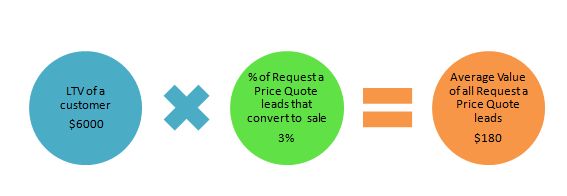Social Media Metrics: Measuring Business Value When Sales Take Place Offline
Social media marketing can be an effective way to generate exposure among potential new customers. Done right, that exposure can be translated into engagement, interest, and eventually, a sale. Unfortunately, social media doesn’t always get the credit it deserves for that sale, especially when transactions do not take place on the web site. Here are […]
Social media marketing can be an effective way to generate exposure among potential new customers. Done right, that exposure can be translated into engagement, interest, and eventually, a sale.
Unfortunately, social media doesn’t always get the credit it deserves for that sale, especially when transactions do not take place on the web site.
Here are two approaches to tracking the business value of social media marketing in this scenario:
Create Goal (Soft Conversion) Values
If a site visitor orders a catalog, asks for a price quote, or signs up to receive email communications, these are promising indicators that a sale is possible in the future. Once you establish the rate at which these types of actions result in a sale, you can assign an estimated value to them.
Here is an example:
ABC Truck Leasing publishes a blog about fleet management and promotes blog content through a variety of social channels. ABC tweets out a new blog post and gets a visitor from Twitter.
After reading the blog post, this visitor begins exploring the ABC web site and eventually fills out a “Request a Price Quote” form (either during the original visit, or on a subsequent visit). The form submission is recorded in ABC’s CRM system.
An analysis of data from ABC’s CRM system shows that 3% of all “Request a Price Quote” submissions eventually result in a sale and the lifetime value of a customer is about $6000.
If 100 “Request a Price Quote” leads are generated and 3% of those can be expected to convert to a sale, the total value of the leads generated is $18,000. But what about the average value of each lead generated? Armed with this information, ABC can perform the following calculation:
Now, through Google Analytics Social Value reports, ABC can see the total number of all “Request a Price Quote” conversions that came from social media sources, both assisted conversions (meaning that social media referred at least one of the visits leading up to conversion, but not the last visit) and last click conversions (meaning that social media referred the visit that immediately preceded the conversion). Even better, ABC can see an estimate of the average value of each lead generated from social sources.
Note the word “estimate”. The average number of people who fill out the “Request a Price Quote” form and subsequently buy is an average. The average number of people who convert to a sale is likely to change over time. Hence, the social value number in Google Analytics is an educated guess.
To avoid being accused of fuzzy math and/or measurement fantasy, the marketing team at ABC should validate the 3% average conversion number on a periodic basis. (Note: The volume of conversions and sales must be high enough to be statistically significant. In other words, an average of 3% based on 100 “Request a Price Quote” submissions and 3 sales would be highly questionable.)
Note that this can be done as a post-campaign analysis as well. For example, online coupons that are downloaded and redeemed in-store can be analyzed after the campaign is over. In this case, the final number would not be an estimate; it would be an accurate total count and value.
Connect The Dots Between CRM Data And Analytics Data
If goal value estimates won’t fly with the powers that be, there is a way to connect the dots between actions taken on your site and an eventual sale. It requires integrating the data in your CRM system with web analytics data.
Here is how it works: When a site visitor fills out the “Request a Price Quote” form, this information is passed to the CRM system. In most cases (even with many free CRM tools like Zoho), you can configure your CRM system to issue a unique ID to the visitor who filled out the form.
This ID can be passed to Google Analytics via ecommerce tracking (Note: Your site must be set up as an ecommerce site to do this). By doing this, you are no longer constrained by the fact that Google Analytics gives you only an aggregate number of price quote requests sourced from social media. You can now put people and actions together, like this:
Using this data, you can calculate a number of rich social media metrics, such as:
- The percentage of socially-referred visitors who submitted a price quote and eventually bought, compared to visitors from other sources.
- The average time to close a social media lead (Request a Price Quote lead) compared to other sources.
- The lifetime value of socially-referred leads who became customers compared to other sources.
Note that both of these approaches have advantages and disadvantages. In the first approach, the impact of social media can be seen further up the funnel (via assist data).
In the second approach, social media is tied to an actual sale, but only last-click sources are included in the analysis. Fortunately, these approaches are not mutually exclusive. In fact, some of the best examples of creative and successful measurement approaches are the result of experimentation with data generated in various ways from different sources.
Remember that even if you can’t formally integrate data sources like CRM systems and web analytics, you can still use data from these systems to make manual calculations that may help you make the case for social media investment.
For example, if you know that the LTV of a new customer is $6,000 (Source: CRM system) and you spend $18,000 per month on social media, your social media efforts must generate 3 sales per month to break even. If 3% of your leads convert to a sale, this means you need to generate 100 leads (Source: Google Analytics) from social media per month.
Happy calculations!
Opinions expressed in this article are those of the guest author and not necessarily MarTech. Staff authors are listed here.
Related stories

